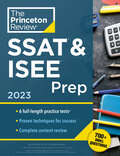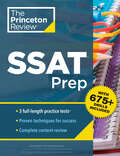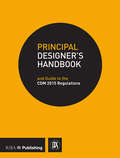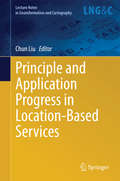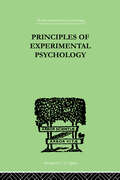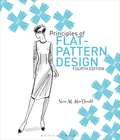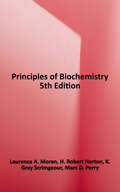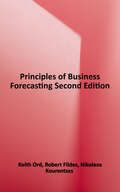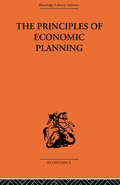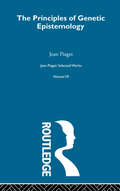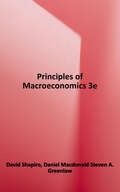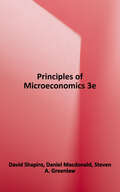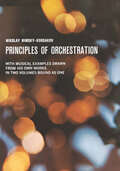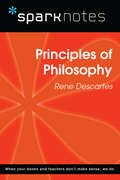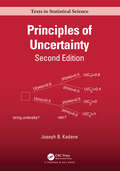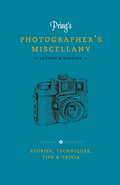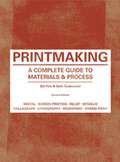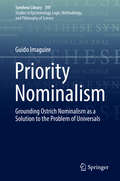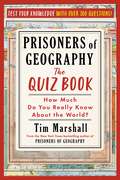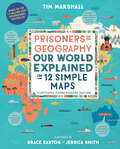- Table View
- List View
Princeton Review SSAT & ISEE Prep, 2023: 6 Practice Tests + Review & Techniques + Drills (Private Test Preparation)
by The Princeton ReviewWORK SMARTER, NOT HARDER, WITH THE PRINCETON REVIEW. Get the prep you need to ace the SSAT & ISEE with 6 full-length practice tests, thorough content reviews, and tons of extra drills in the book.Techniques That Actually Work• Time-saving tips to help you effectively tackle the exams• Problem-solving tactics demonstrated on the trickiest test questions• Point-earning strategies for multiple-choice questionsEverything You Need for a High Score• Complete coverage of the Math, Verbal, and Reading sections for both tests• A thorough review of fundamental math skills and frequently-appearing vocabulary words for the SSAT and ISEE• Information on the at-home testing option for SSAT and ISEE• Study guide access via your online Student ToolsPractice Your Way to Excellence• 5 full-length, in-book practice tests (2 for SSAT, 3 for ISEE) and 1 full-length, downloadable test (SSAT Elementary Level) online, all with detailed explanations• 700+ drill questions across every level, subject, and question type• Online versions of the included in-book exams to help you prepare for at-home testing
Princeton Review SSAT Prep: 3 Practice Tests + Review & Techniques + Drills (Private Test Preparation)
by The Princeton ReviewWORK SMARTER, NOT HARDER, WITH THE PRINCETON REVIEW. Get the prep you need to ace the SSAT with 3 full-length practice tests (2 in the book, 1 online), thorough content reviews, and tons of drills in the book. Techniques That Actually Work • Time-saving tips to help you effectively tackle the exam • Problem-solving tactics demonstrated on the trickiest test questions • Point-earning strategies for multiple-choice questions Everything You Need For a High Score • Comprehensive strategies for the Writing, Math, Verbal, and Reading sections • Detailed coverage of fundamental math skills and frequently appearing vocabulary words for the SSAT® • Information on the SSAT at Home testing option for the Middle and Upper levels • Access to a student study guide via your online Student Tools Practice Your Way to Excellence • 3 full-length practice tests (one Middle and one Upper Level in the book, one Elementary Level online) with detailed answer explanations • 675+ drill questions across every level, subject, and question type to keep track of your progress • Online versions of the Middle and Upper Level tests in the book to help you prepare for at-home testing
Principal Designer's Handbook: Guide to the CDM Regulations 2015
by Association for Project SafetyThe new CDM regulations came into force on 6th April 2015 changing the face of pre-construction health and safety management on construction projects, large and small. This handbook provides a comprehensive road map to undertaking the new Principal Designer role brings pre-construction health and safety risk management into the hands of architects and other designers. Offering authoritative and straightforward guidance to carrying out these tasks, it also uses case studies and checklists to demonstrate how this can be done quickly and efficiently.
Principle and Application Progress in Location-Based Services
by Chun LiuThese proceedings are aimed at researchers, industry / market operators and students from different backgrounds (scientific, engineering and humanistic) whose work is either focused on or affined to Location Based Services (LBS). It contributes to the following areas: positioning / indoor positioning, smart environments and spatial intelligence, spatiotemporal data acquisition, processing, and analysis, data mining and knowledge discovery, personalization and context-aware adaptation, LBS visualization techniques, novel user interfaces and interaction techniques, smart phone navigation and LBS techniques, three-dimensional visualization in the LBS context, augmented reality in an LBS context, innovative LBS systems and applications, way finding /navigation ( indoor/outdoor), indoor navigation databases, user studies and evaluations, privacy issues in LBS, usability issues in LBS, legal and business aspects of LBS, LBS and Web 2. 0, open source solutions and standards, ubiquitous computing, smart cities and seamless positioning.
Principles Of Experimental Psychology
by Piron, HenriFirst Published in 1999. Routledge is an imprint of Taylor & Francis, an informa company.
Principles Of Flat Pattern Design
by Nora M. MacDonaldThe basic principles of the flat-pattern method are the foundation of producing effective apparel designs. Principles of Flat-Pattern Design, 4th Edition, maintains its simple and straightforward presentation of flat-patternmaking principles which is proven to be less intimidating for beginning students. Numbered and fully illustrated steps guide students through a logical series of pattern manipulation procedures, each beginning with a flat sketch of the design to be developed and ending with a representation of the completed pattern. A significant expansion of the introductory chapters in this 4th Edition aligns the patternmaking process with current industry practices, including technological advancements, design analysis, and production basics such as grading, marker making, and specifications.
Principles of Biochemistry, 5th Edition
by Marc D. Perry Laurence A. Moran H. Robert Horton K. Gray ScrimgeourPrinciples of Biochemistry provides a concise introduction to fundamental concepts of biochemistry, striking the right balance of rigor and detail between the encyclopedic volumes and the cursory overview texts available today. Widely praised for accuracy, currency, and clarity of exposition, the Fifth Edition offers a new student-friendly design, an enhanced visual program, new Application Boxes, contemporary research integrated throughout, and updated end-of-chapter problems.
Principles of Business Forecasting, 2nd ed
by Keith Ord Robert Fildes Nikolaos KourentzesThis second edition of Principles of Business Forecasting by Keith Ord, Robert Fildes, and newest author Nikolaos Kourentzes serves as both a textbook for students and as a reference book for experienced forecasters in a variety of fields. The authors' motivation for writing this book, is to give users the tools and insight to make the most effective forecasts drawing on the latest research ideas, without being overly technical. The book is unique in its design, providing an introduction to both standard and advanced forecasting methods, as well as a focus on general principles to guide and simplify forecasting practice for those with little or no professional experience. One of the book's key strengths is the emphasis on real data sets, which have been updated in this second edition. These data sets are taken from government and business sources and are used throughout the chapter examples and exercises. Forecasting techniques are demonstrated using a variety of software platforms beyond just "R," and a companion website provides easy-to-use Excel(R) macros that users can access to conduct analyses. Another important innovation in the second edition is the tutorial support for using open-source R programs, making all the methods available for use both in courses and practice. After the introductory chapters, the focus shifts to using extrapolative methods (exponential smoothing and ARIMA), and then to statistical model-building using multiple regression. The authors also cover more novel techniques including data mining and judgmental methods, which are gaining increasing attention in applications. The second edition also offers expanded material on data analytics, in particular neural nets together with software, and applications that include new research findings relevant and immediately applicable to operations, such as hierarchical modeling and temporal aggregation. Finally, the authors examine organizational issues of implementation and the development of a forecasting support system within an organization; relevant to every manager, or future manager, who must make plans or decisions based on forecasts. Please take a moment to review the companion website for additional content in the Appendices (Basic Statistical Concepts, an overview of Forecasting Software, and Forecasting in R: Tutorial and Examples) the many data sets referenced in the chapters, macros such as the Exponential Smoothing and Trend Curve Marcos and Time Series Neural Network Analysis and student study materials.
Principles of Cyberbullying Research: Definitions, Measures, and Methodology (Routledge Monographs in Mental Health)
by Donna Cross Sheri Bauman Jenny WalkerIn 2010, the International Cyberbullying Think Tank was held in order to discuss questions of definition, measurement, and methodologies related to cyberbullying research. The attendees’ goal was to develop a set of guidelines that current and future researchers could use to improve the quality of their research and advance our understanding of cyberbullying and related issues. This book is the product of their meetings, and is the first volume to provide researchers with a clear set of principles to inform their work on cyberbullying. The contributing authors, all participants in the Think Tank, review the existing research and theoretical frameworks of cyberbullying before exploring topics such as questions of methodology, sampling issues, methods employed so far, psychometric issues that must be considered, ethical considerations, and implications for prevention and intervention efforts. Researchers as well as practitioners seeking information to inform their prevention and intervention programs will find this to be a timely and essential resource.
Principles of Digital Economics: Innovation Theory in the Age of Intelligence (Contributions to Economics)
by Zhiyi LiuThis book aims to "digital economics" as an inter-discipline research area, by integrating economics, philosophy of technology, computer science and sociology. It takes an in-depth look at the history of technology development covering the changes and challenges to the society and thoughts, as it is, which helps readers to understand the logic and operation of the emerging integrated economy. Also a lot of innovation cases in digital transformation of China are presented in this book.
Principles of Economic Planning: A Study Prepared For The Fabian Society (Unwin University Book Ser. #Vol. 11)
by W. Arthur LewisDiscussing the problems arising from a mixed economy, Principles of Economic Planning argues for a system of controls that combine and encourage the best features of laissez faire and state planning. Chapters covering the following are included:* Money* Investment* Foreign Trade* Mobility* The Social Control of Business* NationalizationAppendices on economic union and planning in developing countries are also included.
Principles of Genetic Epistemology: Selected Works vol 7
by Jean PiagetFirst published in 1997. Routledge is an imprint of Taylor & Francis, an informa company.
Principles of Macroeconomics, 3e
by David Shapiro Daniel Macdonald Steven A. GreenlawPrinciples of Macroeconomics 3e covers the scope and sequence of most one-semester introductory macroeconomics courses. The third edition takes a balanced approach to the theory and application of macroeconomic concepts. The text uses conversational language and ample illustrations to explore economic theories and provides a wide array of examples using both fictional and real-world scenarios. The third edition has been carefully and thoroughly updated to reflect current data and understanding, as well as to provide a deeper background on diverse contributors and their impacts on economic thought and analysis. For example, the third edition highlights the research and views of a broader group of economists. Brief references and deeply explored socio-political examples have also been updated to showcase the critical – and sometimes unnoticed – ties between economic developments and topics relevant to students.
Principles of Microeconomics, 3e
by David Shapiro Daniel Macdonald Steven A. GreenlawPrinciples of Microeconomics 3e covers the scope and sequence of most one-semester introductory microeconomics courses. The third edition takes a balanced approach to the theory and application of microeconomics concepts. The text uses conversational language and ample illustrations to explore economic theories and provides a wide array of examples using both fictional and real-world applications. The third edition has been carefully and thoroughly updated to reflect recent developments, as well as to provide a deeper background in diverse contributors and their impacts on economic thought and analysis. For example, the third edition highlights the research and views of a broader group of economists. This is the official print version of this OpenStax textbook. OpenStax makes full-color hardcover and B&W paperback print copies available for students who prefer a hardcopy textbook to go with the free digital version of this OpenStax title. The textbook content is exactly the same as the OpenStax digital book. This textbook is available for free download at the OpenStax dot org website, but as many students prefer to study with hardcopy books, we offer affordable OpenStax textbooks for sale through Amazon as well as most campus bookstores.
Principles of Orchestration
by Nikolai Rimsky-Korsakov"To orchestrate is to create, and this cannot be taught," wrote Nikolay Rimsky-Korsakov, the great Russian composer whose genius for brilliant, highly colored orchestration is unsurpassed. But invention, in all art, is closely allied to technique, and technique can be taught. This book, therefore, which differs from most other texts on the subject because of its tremendous wealth of musical examples and its systematic arrangement of material according to each constituent of the orchestra, will undoubtedly be of value to any music student. It is a music classic, perhaps the only book on classical orchestration written by a major composer.In it, the composer aims to provide the reader with the fundamental principles of modern orchestration from the standpoint of brilliance and imagination, and he devotes considerable space to the study of tonal resonance and orchestral combination. In his course, he demonstrates such things as how to produce a good-sounding chord of certain tone-quality, uniformly distributed; how to detach a melody from its harmonic setting; correct progression of parts; and other similar problems.The first chapter is a general review of orchestral groups, with an instrument-by-instrument breakdown and material on such technical questions as fingering, range, emission of sound, etc. There follows two chapters on melody and harmony in strings, winds, brasses, and combined groups. Chapter IV, Composition of the Orchestra, covers different ways of orchestrating the same music; effects that can be achieved with full tutti; tutti in winds, tutti pizzicato, soli in the strings, etc.; chords; progressions; and so on. The last two chapters deal with opera and include discussion of solo and choral accompaniment, instruments on stage or in the wings, technical terms, soloists (range, register, vocalization, vowels, etc.), voices in combination, and choral singing. Immediately following this text are some 330 pages of musical examples drawn from "Sheherazade," the "Antar Symphony," "Capriccio Espagnol," "Sadko," "Ivan the Terrible," "Le Coq d'Or," "Mlada," "The Tsar's Bride," and others of Rimsky-Korsakov's works. These excerpts are all referred to in the text itself, where they illustrate, far better than words, particular points of theory and actual musical practice. They are largely responsible for making this book the very special (and very useful) publication it is.This single-volume edition also includes a brief preface by the editor and extracts from Rimsky-Korsakov's 1891 draft and final versions of his own preface, as well as an appendixed chart of single tutti chords in the composer's works.
Principles of Philosophy (SparkNotes Philosophy Guide)
by SparkNotesPrinciples of Philosophy (SparkNotes Philosophy Guide) Making the reading experience fun! SparkNotes Philosophy Guides are one-stop guides to the great works of philosophy–masterpieces that stand at the foundations of Western thought. Inside each Philosophy Guide you&’ll find insightful overviews of great philosophical works of the Western world.
Principles of Uncertainty (Chapman & Hall/CRC Texts in Statistical Science)
by Joseph B. KadanePraise for the first edition: Principles of Uncertainty is a profound and mesmerising book on the foundations and principles of subjectivist or behaviouristic Bayesian analysis. … the book is a pleasure to read. And highly recommended for teaching as it can be used at many different levels. … A must-read for sure!—Christian Robert, CHANCEIt's a lovely book, one that I hope will be widely adopted as a course textbook.—Michael Jordan, University of California, Berkeley, USALike the prize-winning first edition, Principles of Uncertainty, Second Edition is an accessible, comprehensive text on the theory of Bayesian Statistics written in an appealing, inviting style, and packed with interesting examples. It presents an introduction to the subjective Bayesian approach which has played a pivotal role in game theory, economics, and the recent boom in Markov Chain Monte Carlo methods. This new edition has been updated throughout and features new material on Nonparametric Bayesian Methods, the Dirichlet distribution, a simple proof of the central limit theorem, and new problems.Key Features: First edition won the 2011 DeGroot Prize Well-written introduction to theory of Bayesian statistics Each of the introductory chapters begins by introducing one new concept or assumption Uses "just-in-time mathematics"—the introduction to mathematical ideas just before they are applied
Pring's Photographer's Miscellany: Stories, Techniques, Tips & Trivia
by Roger Pring***How did Kodak company get its name? Who invented the Minox spy camera? Were there really fax machines in the mid-19th century? And what would a photographer use 'Mod Podge' for? The answers to all these questions and many, many more can be found in this intriguing compendium of photographic fascination compiled by Roger Pring.Beautifully packaged, full of arresting images and exquisitely typeset by the author himself, Pring's Photographer's Miscellany will make an intriguing gift for all photographers. Dipping into the book will reveal the origins of the photographer's craft, tips and tricks of the greats, a host of revealing quotes and fascinating trivia: and you'll not only be richly entertained, you'll certainly learn something you can use next time you shoot.
Pring's Photographer's Miscellany: Stories, Techniques, Tips & Trivia
by Roger Pring***How did Kodak company get its name? Who invented the Minox spy camera? Were there really fax machines in the mid-19th century? And what would a photographer use 'Mod Podge' for? The answers to all these questions and many, many more can be found in this intriguing compendium of photographic fascination compiled by Roger Pring.Beautifully packaged, full of arresting images and exquisitely typeset by the author himself, Pring's Photographer's Miscellany will make an intriguing gift for all photographers. Dipping into the book will reveal the origins of the photographer's craft, tips and tricks of the greats, a host of revealing quotes and fascinating trivia: and you'll not only be richly entertained, you'll certainly learn something you can use next time you shoot.
Printmaking Second Edition: A Complete Guide to Materials & Process
by Bill Fick Beth GrabowskiPrintmaking is a practical and comprehensive guide to printmaking techniques. This fully updated edition includes expanded chapters on digital and mixed media processes, and a brand new 'Print & Make' chapter, which explores the opportunities for creative expression within the many processes available to print makers. The more traditional techniques of relief, intaglio, collograph, lithography, screen printing and monoprint have also been refreshed with the addition of new images showing a broader range of subject matter, including more contemporary prints and international artists. Each technique is explored from the development of the printing or digital matrix, through the different stages of creation to image output. Guidance on how to set up a print studio, sections on troubleshooting techniques and the inclusion of up-to-date lists of suppliers, workshops and galleries make this an essential volume for beginner and experienced printmakers alike.
Printmaking Second Edition: A Complete Guide to Materials & Process
by Bill Fick Beth GrabowskiPrintmaking is a practical and comprehensive guide to printmaking techniques. This fully updated edition includes expanded chapters on digital and mixed media processes, and a brand new 'Print & Make' chapter, which explores the opportunities for creative expression within the many processes available to print makers. The more traditional techniques of relief, intaglio, collograph, lithography, screen printing and monoprint have also been refreshed with the addition of new images showing a broader range of subject matter, including more contemporary prints and international artists. Each technique is explored from the development of the printing or digital matrix, through the different stages of creation to image output. Guidance on how to set up a print studio, sections on troubleshooting techniques and the inclusion of up-to-date lists of suppliers, workshops and galleries make this an essential volume for beginner and experienced printmakers alike.
Printreading for Residential Construction, Sixth Edition
by Thomas E. Proctor Leonard P. ToenjesPrintreading for Residential Constructionpresents printreading fundamentals and provides printreading activities related to residential construction. Topics presented include sketching, computer-aided design (CAD), trade math symbols and abbreviations, plot plans, floor plans, elevations, sections, and details. This new edition provides information on revised building codes, LEED for Homes, green building practices, advanced house framing techniques, insulation, and the whole-house systems approach. Content Overview Construction Documents Working Drawing Concepts Trade Math Symbols and Abbreviations Plot Plans Floor Plans Elevations Sections Details Trade Information - Foundations, Framing, and Finishes Trade Information - Electrical, Plumbing, and HVAC Final Review and Exams Appendix Glossary Index
Priority Nominalism: Grounding Ostrich Nominalism as a Solution to the Problem of Universals (Synthese Library #397)
by Guido ImaguireThis monograph details a new solution to an old problem of metaphysics. It presents an improved version of Ostrich Nominalism to solve the Problem of Universals. This innovative approach allows one to resolve the different formulations of the Problem, which represents an important meta-metaphysical achievement.In order to accomplish this ambitious task, the author appeals to the notion and logic of ontological grounding. Instead of defending Quine’s original principle of ontological commitment, he proposes the principle of grounded ontological commitment. This represents an entirely new application of grounding.Some metaphysicians regard Ostrich Nominalism as a rejection of the problem rather than a proper solution to it. To counter this, the author presents solutions for each of the formulations. These include: the problem of predication, the problem of abstract reference, and the One Over Many as well as the Many Over One and the Similar but Different variants.This book will appeal to anyone interested in contemporary metaphysics. It will also serve as an ideal resource to scholars working on the history of philosophy. Many will recognize in the solution insights resembling those of traditional philosophers, especially of the Middle Ages.
Prisoners of Geography: How Much Do You Really Know About the World?
by Tim MarshallPut your geographical and political knowledge to the test and discover your geography IQ with this engaging collection of 300+ questions, puzzles, word games, and maps from New York Times bestselling author Tim Marshall.&“In an ever more complex, chaotic, and interlinked world, Prisoners of Geography is a concise and useful primer on geopolitics&” (Newsweek). Ever wonder just how much you really know about the world? Now, in this interactive quiz book based on the New York Times bestselling Prisoners of Geography, you can test yourself on topics every world citizen should know. Do you know your continents from your countries, your landmarks from your latitudes, your mountain ranges from your rivers? Covering every area of the world—from New Orleans to NATO and from Russia to Rhode Island—the book tests your expertise with a variety of questions, puzzles, word games and maps, designed to challenge you while expanding your world knowledge. With refreshing insights and his trademark wit, Marshall continues to make complex geopolitical strategies that shape the world accessible to millions around the globe. From trivia fans to international history buffs, this illuminating, interactive quiz book is a fun way to challenge your friends and family and discover who is the ultimate expert on world affairs.
Prisoners of Geography: Our World Explained In 12 Simple Maps (illustrated Young Readers Edition) (Politics Of Place Ser. #1)
by Tim Marshall“For curious children ages 7–15, Prisoners of Geography has lots to fascinate.”—The Wall Street Journal The secret world history written in the mountains, rivers, and seas that shape every country’s politics, economy, and international relations—and our own lives—is revealed in this illustrated young readers edition of Prisoners of Geography, the million-copy international bestseller. History is a story—and it’s impossible to tell the whole tale without understanding the setting. In this eye-opening illustrated edition of the international bestseller Prisoners of Geography, you’ll learn to spot connections between geography and world affairs in ways you never noticed before. How did the US’s rivers help it become a superpower? Why are harsh, cold and swampy Siberia and the Russian Far East two of that country’s most prized regions? How come Japan prefers to trade along the coasts instead of across its land? What do the Himalayas have to do with war? With colorful maps that capture every continent and region, plus hundreds of illustrations that illuminate how our surroundings shape us, this one-of-a-kind atlas will inspire curious minds of all ages!
